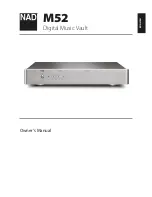
!
F3 Manifold Bases With Interconnect Wiring
V419DP
1. Line up Manifolds (Item 9) in order of assembly while viewing
cylinder ports #2 and #4. Assembly is from right to left.
Place the Right End Plate (Item 1) at the right end of the
bank. See Figure 4.
2. Each manifold should be accompanied with three Tie Rods
(Item 2). Screw together all the tie rods into three sets of
equal length — each set will number the same as the number
of manifolds to be stacked.
3. Thread each set of Tie Rods into the Right End Plate then
place the end so that the tie rods are pointing up away from
the assembly surface.
NOTE: When assembling a manifold
greater than 5 stations, back each tie rod out 2 turns.
This will allow engagement of the End Plate Screws to
the last station.
4. Apply a light coating of grease to molded gasket (Item 3)
and place it in groove of right end plate (Item 1).
5. Assemble first manifold in sequence to right end plate allowing
the three tie rod sets to pass through the manifold holes.
6. In like manner, install another greased gasket and place the
second manifold in sequence over the first. Assemble
remaining manifolds by repeating steps 4 and 5.
7. Assemble the last gasket to the last manifold, then mount
the Interface Plate (Item 5) with three socket head cap
screws (Item 6). Start the screws into the last tie rods but
do not tighten the screws at this stage.
8. Place the entire assembly on a flat surface, align for
straightness and alternately tighten each screw incrementally.
Final torque should be 4.5 to 5.1 Nm (40 to 45 in. lb.)
9. Attach four Tie Rods (Item 9) to the Interface Plate (Item 5)
then mount the Gasket (Item 7), Interconnect Wiring Module
(Item 6), Gasket (Item 7) and Cover Item 10) over the Tie
Rods. Attach these components with the four Screws (Item
11) and Washers (Item 12) provided. NOTE: The 25-Pin
Sub-D Interconnect Wiring Module has a ground wire with
ring terminal which must be attached to the inner green
screw on the Interface Plate before cover is attached.
10. NOTE: Transition Plates or Isolation Plugs must be properly
placed as the construction of the stack progresses. See
individual sections of this bulletin.
11. Add valves and accessories to the manifold (if not already
attached). The final assembly should be leak and electrically
tested before operation.
Accessory Assembly
Manifold Isolation Procedures:
Inlet & exhaust galleries, and pilot supply / signal galleries may
be isolated from those in adjacent manifolds through the use of
isolation plugs. Note: air piloted valves, whether single or double,
will need to be isolated at 14 and/or 12 galleries to prevent
improper air pressure signals reaching adjacent valves. Figure
5 schematically indicates where to place plugs (shown as “X”
marks) for typical air piloted valves. Figure 4 pictorially indicates
assembly locations of main gallery plugs (Item 1), which are
assembled on the left side of the base. The pilot gallery plugs
(Item 2), are assembled on the right side of the base.
The following describes how to install these plugs:
1. Determine which gallery is to be isolated between two
manifolds.
2. As displayed in Figure 6, use the large plugs (Item 1) from
the service kits to isolate manifolds from the main gallery(s).
The middle plug is used to isolate port #1 (inlet air supply),
the left plug is used to isolate port #5 and the right plug is
used to isolate port #3.
3. Apply a light coating of grease to isolation plug o-ring and
insert it into counterbore.
4. Apply a light coating of grease to gasket (Item 3) and
assemble in manifold groove.
2 of 4
1
9
8
7
12
10
2
3
11
6
5
4
Pin
Number
1
2
3
4
5
6
7
8
9
10
11
12
Address
Number
2
4
5
6
7
8
L2
---
Ground
1
L1
3
Connector A
Pin
Number
1
2
3
4
5
6
7
8
9
10
11
12
Address
Number
10
12
13
14
15
16
L2
---
Ground
9
L1
11
Connector B
Supply 120 VAC
1
9
8
7
12
10
2
3
11
6
5
4
Pin
Number
1
2
3
4
5
6
7
8
9
10
11
12
Address
Number
1
2
3
4
5
6
7
8
Ground
N.C.
Common
V+ (N.C.)
Connector A
Pin
Number
1
2
3
4
5
6
7
8
9
10
11
12
Address
Number
9
10
11
12
13
14
15
16
Ground
N.C.
Common
V+ (N.C.)
Connector B
Supply 10-30 VDC
A
B
Figure 3 (12-Pin Round Dual Shown)
Figure 1 (25-Pin Sub-D)
Figure 2 (19-Pin Round)
1
12
11
13
14
15
16
17
18
19
2
3
4
8
9
10
5
7
6
Pin
Number
1
2
3
4
5
6
7
8
9
Address
Number
1
2
3
4
N/A
5
Common
6
7
Pin
Number
10
11
12
13
14
15
16
17
18
19
Address
Number
8
9
Ground
10
11
12
13
14
15
16
1
2
3
4
5
6
7
8
9
10
11
12
13
1
3
5
7
9
11
13
15
17
19
21
23
Common
2
4
6
8
10
12
14
16
18
20
22
24
14
15
16
17
18
19
20
21
22
23
24
25
Manifold
Address
Manifold
Address
Pin
Number
Pin
Number
Manifold Assembly
The Interconnect Wiring System makes the electrical connection
user friendly. Each individual manifold base carries its own
connector circuit board which self aligns and plugs into the
circuit board of the mating manifold base. So no special attention
is required. The power is supplied at the left end of the stack (as
you are viewing the cylinder ports) by means of a plug-in harness
emerging from a Interconnect Wiring Module Kit.
Manifolds may be assembled to one another either before or
after assembling the valves to manifolds. If inlet or exhaust
common galleries are to be isolated from neighboring manifolds,
follow instructions given in the
Manifold Isolation Procedures
section before proceeding with this section. If air pilot valves
are part of the manifold assembly, be sure to isolate their pilot
signals so that they do not supply undesirable pressure to
other valves in the manifold assembly.
Manifold Application
Valves may be arranged into a modular manifold assembly. This
may have up to any number of stations providing that sufficient
pressure is obtained in the circuits downstream of the valve
outlets; and sufficient pressure is available for shifting the valves.
Means to increase pressure levels include supply air at both
end plates (Item 1), at intermediate inlets and sequencing the
valve operation to maximize time between different valve shifts.
WARNING: Air exhausting from one valve into the
exhaust gallery of the manifold assembly may momentarily
pressurize other valve circuits open to the same gallery.
Design the circuit such that there is no hazard or
consequence of damage from this action.
















































